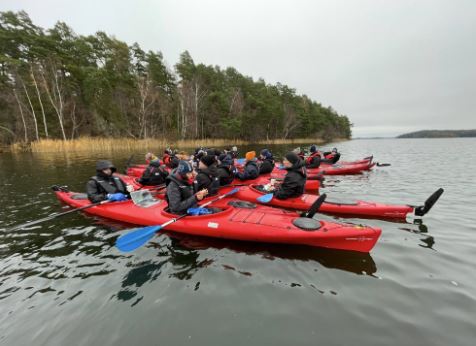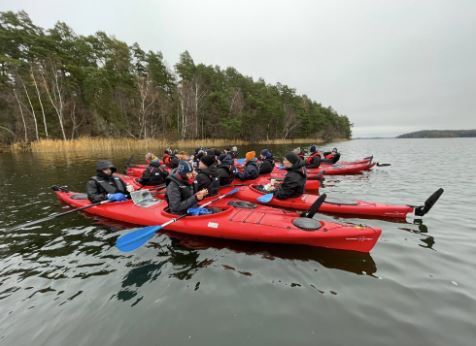
The Executive Transition Program (ETP) is one of ESMT Berlin’s flagship programs, taking senior leaders through a rigorous 18-day professional development learning experience to prepare them for the challenges of leading an organization. But exactly how does ESMT deliver executive leadership training?
It’s no secret that the ETP is not a regular executive education program. The program’s length and the activities undertaken are specifically designed to establish new skills, help you identify your ideal leadership presence and build bonds with fellow participants to strengthen your professional network long into your career.
We spoke to program director, Dr. Sarah Horn, to find out what makes the ETP so special.
Business simulations, peer coaching and… kayaking?
Fresh from wrapping up the first module of ETP’s 2023 intake in Sweden, Sarah reflected on the wealth of experiences from the first eight days of the program.
Sarah Horn: “So far, the executive leadership training has focused on building a strong foundation – forming the peer group and filling technical general management knowledge gaps.
The initial opportunity for bonding and meeting each other at a human level is critical to lay the foundation for strong peer support and vulnerable discussions over the course of the program.
But we also jump straight into the essential technical competencies required of executive leadership, through functional deep-dives. Following this, a business simulation allows us to immediately apply both old and new insights.
In other words, we kick off the program by taking everyone through a mini-MBA. So far, we have guided the group through functional discussions on topics such as operations and supply chain management as an enabler of sales; marketing and commercialization; and financial management and value creation in the context of sustainability considerations.
The program wrapped up with a general manager simulation and discussions on how we can create psychological safety in high-risk organizations such as those operating in aviation or healthcare. We also focused on the importance of bringing in evidence and of depersonalizing managerial decision-making.”

Making the most of module one’s Swedish setting
The program takes advantage of module one’s Swedish setting to heighten the developmental experiences taking place.
On Day 2, the program participants grounded themselves in the local setting by going for a silent walk through the surrounding woods, kayaking on the 5°C waters of Lake Mälaren or even taking a two-minute plunge into the water. All of this was part of the process of establishing closer bonds with one another and fostering an environment where peer-to-peer coaching and growth at a deeper human level can thrive. Kayaking in the challenging conditions of the Swedish winter also held important lessons on (self-)leadership.
Sarah Horn: “Being or becoming a responsible leader is increasingly a courageous balancing act and mental health choice rather than an obvious path for top performers in an organization. Modern leaders have to perform under stress and adversity, interpret and make decisions about incomprehensible external events, and face increasing demands on emotional self-regulation. Being a good, happy leader requires making an intentional, conscious decision to take on that responsibility. ”
Looking ahead to modules two and three
With the 2023 intake of the Executive Transition Program completing their first module in Sweden, what can they, and potential future participants of the program, expect from the second and third modules that both take place in Berlin?
Sarah Horn: “This was only the beginning of another exciting ETP journey. I am very much looking forward to welcoming this year’s ETP participants to Berlin for the next module in February.
Before module two starts participants can benefit from the program’s inter-modular phase, which dives into managerial areas that used to be known and understood as distinct, separate functions but are now every leader’s task. Examples are artificial intelligence, data Analytics, HR or IT.
In this period, we also spend time exploring the transition journey everyone is on. Learning about what one could have done better in previous transitions, and exploring what lies ahead is a critical step in setting ourselves up for success.”
Executive leadership training in Berlin
When current participants join us again in Berlin in February they can look forward to learning more about strategy and the need to consider macro-economic, political or societal trends, change leadership, and innovation management. There will also be time for exchanging perspectives and peer coaching whilst exploring the unique aspects of Berlin, including the city’s unique history.
In the final module that takes place in May, ETP program concludes with a deep-dive on self-leadership facilitated by executive coaches and experiential learning moments. This, however, does not conclude the ETP journey. Every year we invite alumni to campus to continue their journey and meet peers from all past cohorts.
If you would like more details about the second part of the program, contact your program advisor Beatrix Becker, head of business development at ESMT.
Alternatively read our interview with ETP Alumnus Jens Delventhal to find out more about the impact of the program, or check out our ETP video on YouTube to hear from more alumni of the program.
Interested in accelerating your transition to senior leadership? Apply now and join the Executive Transition Program in 2024.

I like training and empowering people for better tomorrow.